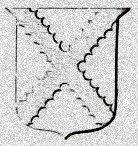Related Research Articles
George Brown was a late 15th-century and early 16th-century Scottish churchman. He first appears on record in 1478 as the rector of the church of Tyningham, and is called a clerk of the diocese of Brechin. In 1482, he was selected to be Chancellor of the diocese of Aberdeen.

Alexander de Kininmund was a 14th-century Scottish cleric. Although it is not known which one, it is known that in his youth he went to university and achieved a Licentiate in the Arts.

Archibald was a Scottish prelate best known for involvement in a dispute with the Pope.
Ninian Spot [de Spot] was a royal clerk and prelate in the 15th century Kingdom of Scotland. He spent much of his youth at university, eventually obtaining Master's Degree.
Thomas de Dundee, also called Thomas Nicholay, was a Scottish prelate who held the bishopric of Ross during the First War of Scottish Independence. Coming from a family of Dundee burgesses, he was educated as the University of Bologna, before entering into career in the church.
Alexander de Kylwos – written alternatively as Frylquhous, Kylquos, and a variety of other forms – was a Scottish churchman and prelate active in the second half of the 14th century. He is known to have held senior positions in three bishoprics, and senior offices in two, before being elected and appointed Bishop of Ross in 1371. Though his episcopate is relatively obscure, he seems to have spent almost all of it inside or around his province, was closely associated with William III and Euphemia I, successive rulers of Ross, and was an associate of the famous Alexander Bur, Bishop of Moray, during the latter's struggle with Alexander Stewart, the son of the King later known by the nickname "Wolf of Badenoch".

Albin was a 13th-century prelate of the Kingdom of Scotland. A university graduate, Albin is known for his ecclesiastical career in the diocese of Brechin, centred on Angus in east-central Scotland.

Nicholas de Balmyle, also called Nicholas of St Andrews, was a Scottish administrator and prelate in the late 13th century and early 14th century. A graduate of an unknown university, he served his earliest years as a clergyman at St Andrews, moving on to hold churches in Lothian as well as deputising to two archdeacons of Lothian.

Nicholas O. Tiron, Abbot of Arbroath and Bishop of Dunblane, was a late 13th-century and early 14th-century churchman in the Kingdom of Scotland. Little is known about Nicholas until he appeared on 21 November 1299, holding the position of Abbot of Arbroath in a charter of that abbey; the last attestation of his predecessor Henry can be dated to 16 October 1296, so that Nicholas must have become abbot sometime in between these two dates.
William de Cambuslang was a 14th-century Scottish churchman, presumably coming from a family based at or originating from Cambuslang near Glasgow.
John Herspolz or John Hepburn was Bishop of Dunblane. On the day of the resignation of the bishopric of Dunblane by Robert Lauder at the papal curia – 12 September 1466 – Pope Paul II provided Herspolz/Hepburn as Lauder's successor.
John Spalding was a 15th-century churchman based at Brechin in Angus, Scotland. Spalding became Dean of Brechin in 1456; he was confirmed in this position by the Pope on 5 October 1458.

James Chisholm, Bishop of Dunblane, was the eldest son of Edmund Chisholm, the first Chisholm to own the estate of Cromlix in Dunblane parish, Strathearn, having moved from the Scottish Borders. In his early years as a clergyman, he was a chaplain to King James III of Scotland; the king apparently sent him to Rome for some time.
The Archdeacon of Brechin was the only archdeacon in the diocese of Brechin, acting as a subordinate of the Bishop of Brechin. The archdeacon held the parish church of Strachan as a prebend from at least 1274.

Gregory of Brechin was a 13th-century prelate based in the Kingdom of Scotland.

John Hepburn was provided bishop of Brechin, Scotland, by Pope Leo X on 29 October 1516, but there may have been a delay in consecrating him due to his "defect of age". He may not have been consecrated until sometime between June 1522 and 23 February 1523, though the evidence is complex and contradictory.

William de Crachin was a prelate active in the Kingdom of Scotland in the 13th century. The earliest known Dean of Brechin Cathedral, his first appearance in a surviving source comes 22 September 1248, from a document of Arbroath Abbey.
George Shoreswood or Schoriswood, was a prelate active in the Kingdom of Scotland during the 15th century. He appears to have been of English-speaking origin, from the family of Bedshiel in Berwickshire.
John de Crannach was a 15th-century Scottish scholar, diplomat and prelate. Originating in the north-east of Lowland Scotland, he probably came from a family associated with the burgh of Aberdeen. Like many of his relatives, he flourished in the 15th-century Scottish church. After just over a decade at the University of Paris, Crannach became a servant of the then Dauphin Charles (VII).
Walter Forrester, bishop of Brechin, was an administrator and prelate in later medieval Scotland. Originating in Angus, he came from a family of English origin who by the end of the 14th century had become well established in Scottish society. A student of the University of Paris and University of Orleans, he began his career at home by the later 1370s.
References
- Dowden, John (1912), Thomson, John Maitland (ed.), The Bishops of Scotland : Being Notes on the Lives of All the Bishops, under Each of the Sees, Prior to the Reformation, Glasgow: James Maclehose and Sons
- Watt, D. E. R.; Murray, A. L., eds. (2003), Fasti Ecclesiae Scotinanae Medii Aevi ad annum 1638, The Scottish Record Society, New Series, Volume 25 (Revised ed.), Edinburgh: The Scottish Record Society, ISBN 0-902054-19-8, ISSN 0143-9448